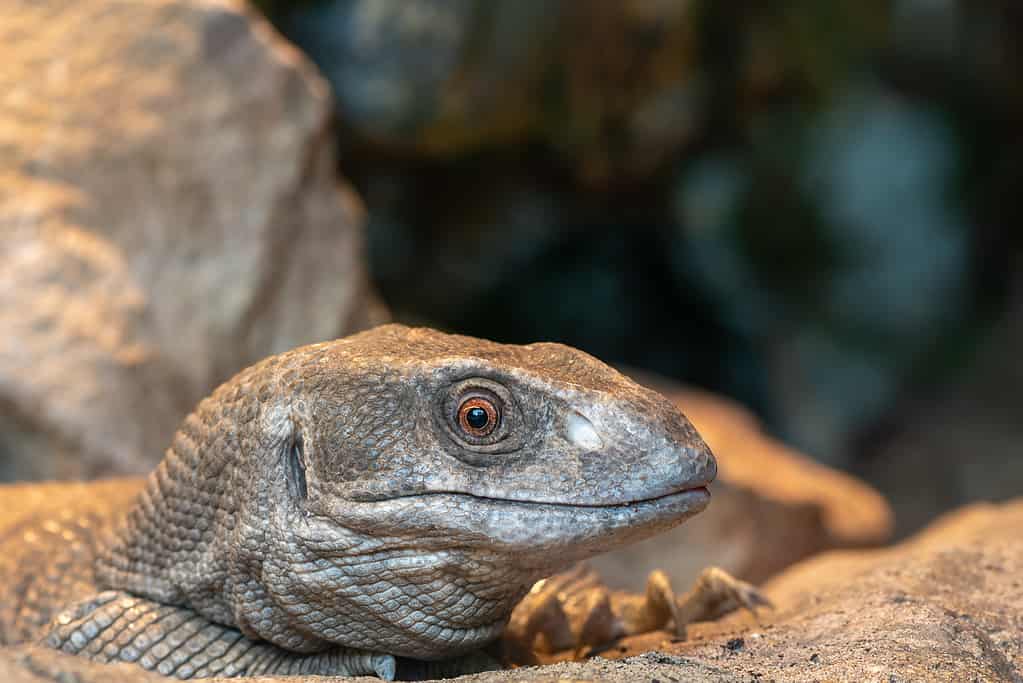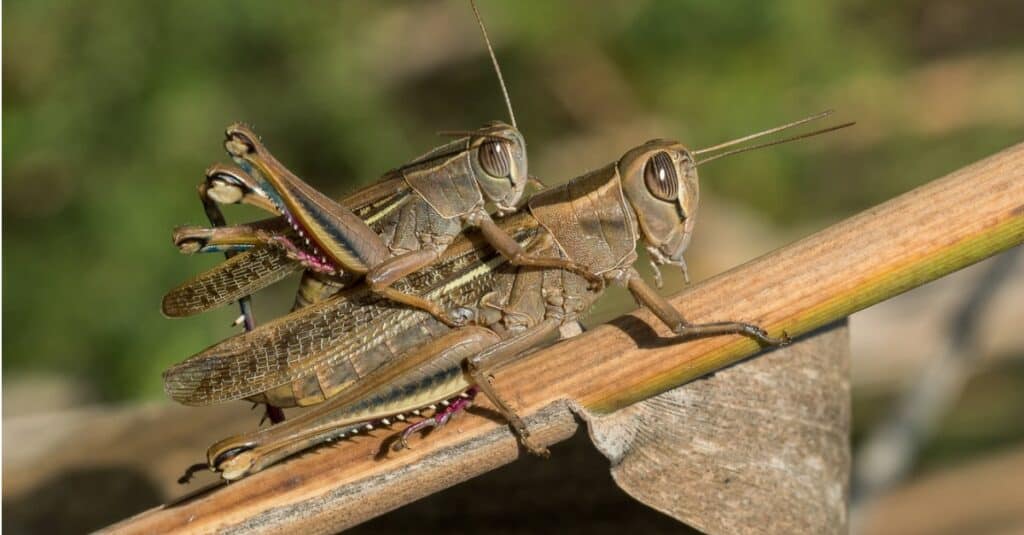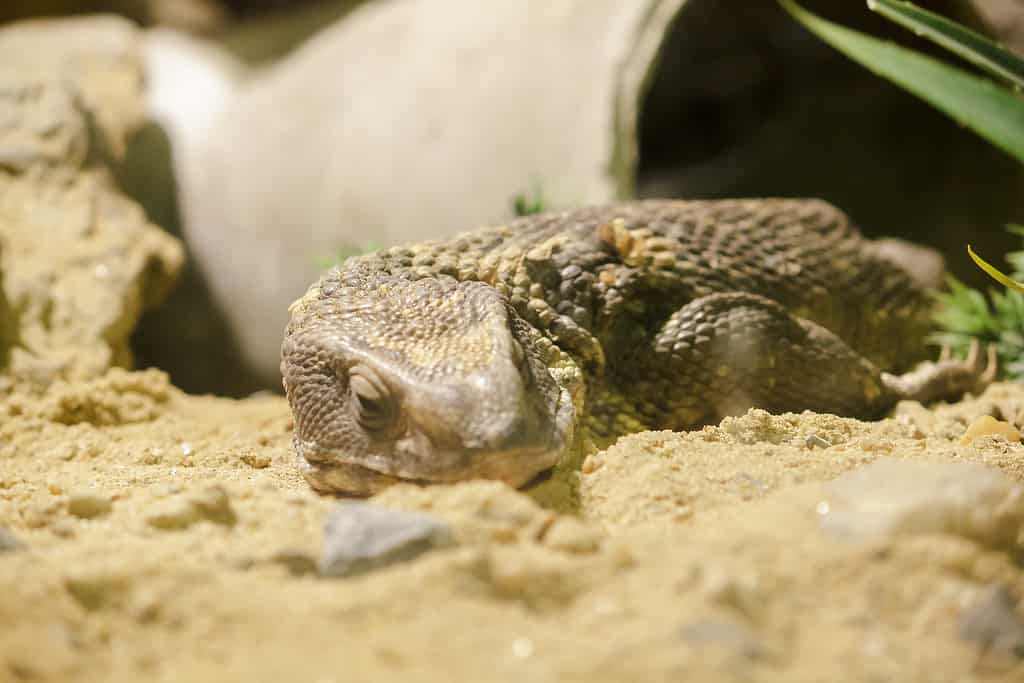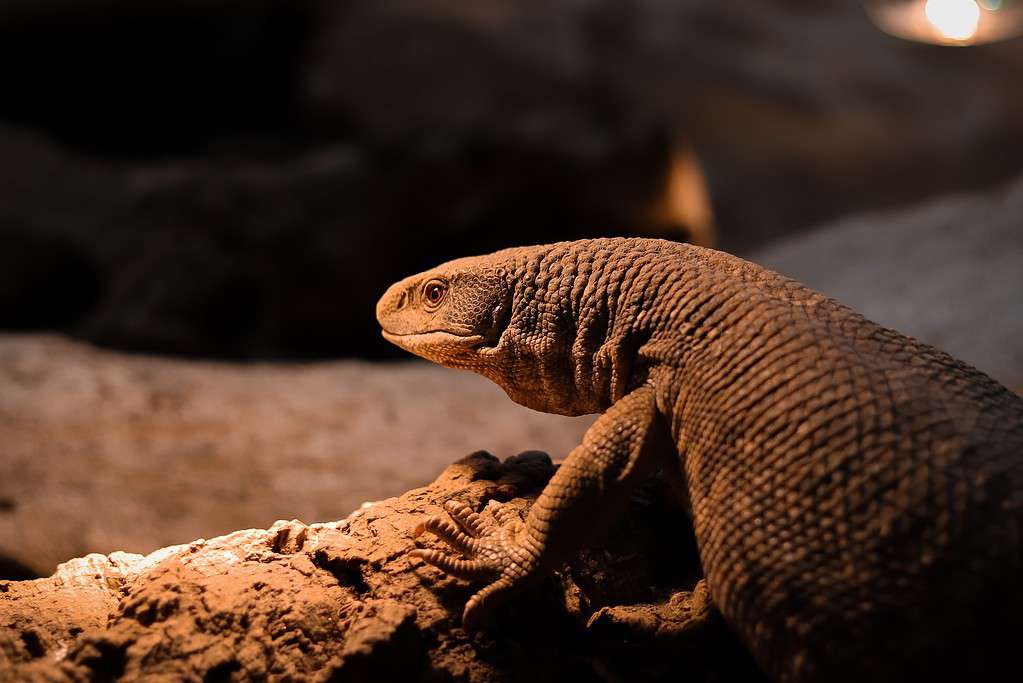Savannah monitors (Varanus exanthematicus) have become extremely popular pet reptiles in recent years, and with good reason. These squat monitors tame easily and are the perfect size for cuddling. You’ll find cute pictures of savannah monitors cuddling with their owners and going for walks all over social media. Therefore, you may wonder if a savannah monitor is a good pet.
When compared to other well-known pet monitor lizards, savannah monitors are relatively simple to care for. While they’re still sizeable and have large habitat requirements, they don’t grow as big. They’re just as intelligent and hardy, though. Their ability to easily socialize with humans has made savannah monitors the most common monitor lizard in the pet trade.
However, many animal shelters and rescues also end up with a significant number of savannah monitors annually. They get bigger than expected, or the owners are in over their heads with care requirements. Savannah monitor care isn’t as complicated as other exotics, however, they aren’t a good choice for first-time reptile owners.
Is a savannah monitor a good pet? Is it the right pet reptile for you? While they can make fantastic pets, here’s what you need to know if you’re considering a savannah monitor.
Basic Facts About Savannah Monitors

Savannah monitors get their name because they love to curiously monitor their native African savannah!
©Tom Meaker/ via Getty Images
Savannah monitors can grow to about 3 feet long and live 10-12 years. They are native to West African countries like Ethiopia, Senegal, and Kenya.
Because many parts of West Africa experience seasonal dryness, savannah monitor habitats need to account for this as well. Most of the year, they prefer an environment that emulates their sparse native grasslands.
Most monitors love to dig, and savannah monitors are no exception. It’s crucial to use proper substrate so your savannah monitor can dig deep tunnels that allow it to burrow. They do this for coolness, enrichment, and eventual egg-laying. Organic soil free of mixed-in fertilizers or pesticides is the best substrate to use. A deep and tightly-packed layer at least 15-20 inches deep needs to be added for adults. For babies, you only need a thin layer that is 2-3 inches deep.
Savannah monitors love to bask just as much as they love to burrow. Make sure your savannah monitor has a sufficient basking area that reaches high temperatures but also a proper heat gradient. They need cool and shady places to go if overheated.
Savannah monitors can become very tame and friendly towards humans but prefer to be solitary in captivity. If you want multiple savannah monitors, it’s best to keep them in separate enclosures so they don’t fight.
Savannah Monitor Diet

Savannah monitors need to eat many orthopteran insects, like crickets and grasshoppers, as babies and juveniles. Winged adult grasshoppers and dubia roaches should be fed to them as adults.
©iStock.com/Brufal
Like most monitor species, savannah monitors are voracious eaters and highly food-motivated. They will eat carrion and smaller animals, but they are mostly insectivorous. Their dietary needs will also change as they get older.
In captivity, baby and juvenile savannah monitors should mostly eat live orthopteran insects. This means crickets and grasshoppers, but crickets are more economical and readily available at local pet stores. Orthopteran insects should be the staple of young savannah monitors’ diets, but small dubia roaches can be included. Growing superworms into beetles also provides variety and enrichment for your savannah monitor. Try feeding rat and mouse pinkies, cooked egg whites, ground chicken or turkey, and small pieces of fish for variety.
Insects should be gut-loaded with a low-protein diet consisting of leafy greens or specially designed gut-loading powders like Mazuri Better Bug. Dust the gut-loaded insects with a calcium powder before feeding them to your savannah monitor. Once a week, the insects should also be sprinkled with a multivitamin powder containing D3. Egg-laying female monitors need more D3 during the egg production stage.
Differences Between Feeding Baby and Adult Savannah Monitors
As adults, savannah monitors shift to a more carnivorous diet. Whole hard-cooked eggs, shrimp, and medium-sized fish provide excellent nutrition and variety. Adult savannah monitors can also eat whole prey like thawed mice and chicks. You don’t need to worry about shells and bones, savannah monitors have strong stomach acid and they provide much-needed calcium. Adults should also eat large gut-loaded insects like winged grasshoppers and adult dubia roaches.
Babies and juveniles need to be fed daily. Adults only need to be fed once or twice a week. This is because savannah monitors are prone to obesity in captivity. They are highly food-motivated and don’t experience post-breeding season diapause like they do in the wild (they don’t eat for 1-2 months during diapause). To prevent savannah monitors from becoming obese, many reptile keepers opt for feeding larger quantities of adult insects. Some whole prey items should be occasionally fed for variety, but thawed mice are high in fat.
Financial Considerations of Keeping a Savannah Monitor

Make sure your savannah monitor enclosure has a tight-packed substrate.
©iStock/ via Getty Images
Keeping a savannah monitor, especially a healthy one with an ideal enclosure, carries steep upfront costs. These costs have less to do with buying the actual savannah monitor and more to do with feeding and the enclosure setup.
Buying an imported savannah monitor can cost as little as $25-50, but imported babies will often have health problems. It’s always best to take a new pet reptile to the vet right after you bring them home. It’s especially crucial for wild-caught imports. It’s more ethical to get a captive-born and bred (CBB) savannah monitor for $80-100. It is less likely to have major health problems and subsequent expensive vet bills. As a bonus, CBB monitors have been socialized to be around people from the day they hatched. This will vastly shorten the time it takes to tame your savannah monitor and build a bond.
You can also easily find savannah monitors for free or with low adoption fees at reptile rescues. Many people often surrender them due to their size and the care requirements being more than they could handle. You won’t have the amazing experience of raising a savannah monitor from a hatchling. But you’ll have the rewarding feeling of providing a loving new home to a surrendered pet.
Nevertheless, savannah monitor husbandry needs cost way more than the lizard itself.
Savannah Monitor Habitat Costs
Modular habitats of the large size that savannah monitors require easily cost upwards of $1,200. It’s significantly cheaper to buy materials and build an enclosure yourself if you have the carpentry skills. Paying an individual crafter or handyman to help can cost hundreds of dollars, plus the cost of materials.
Ongoing costs also must be considered. Buying large quantities of feeder insects on a regular basis can hit your wallet hard. Adult dubia roaches and grasshoppers can cost as much as $2 per bug.
Savannah monitors also go through immense quantities of substrate compared to other monitor species. You can purchase organic soil at most gardening stores for significantly less than exotic pet-branded substrates. Still, you will go through several sacks quickly once your savannah monitor reaches adulthood. The substrate must be at least 15-20 inches deep, if not deeper, and changed every 14-16 days to prevent infections.
Best Enclosure Size for Savannah Monitor Comfort and Health

You need a large enclosure that measures twice your pet’s length for your savannah monitor.
©Fuadi Afif/Shutterstock.com
The enclosure length for most monitor lizards should be more than twice the length of the lizard. Savannah monitors grow to 3 feet on average, so the length should be at least 8 feet. Four feet high is the standard enclosure height.
The standard for savannah monitor enclosures is 8 x 4 x 3, but many reptile keepers opt for larger sizes. This ensures their lizard is happy and has enough room for all the lighting and enrichment they require. Custom modular habitats are a popular way to properly house your savannah monitor if you don’t have a spare bedroom.
Wooden enclosures are excellent for savannah monitors since they need high heat, and wood retains heat better than glass. The temperature needs to be 95-100℉ with 110-130℉ for the basking area. The cool side should be 85℉, with the temperature dropping to 75℉ at night.
Baby savannah monitors do not need a transitional habitat and can start living in their forever home. However, many people start them with a standard 40-gallon terrarium until they get too big and need a larger enclosure.
UVB Bulbs for Savannah Monitors
The enclosure should have a UVB bulb of at least 8-10% to prevent metabolic bone disease. This bulb needs to be changed every six months even if it has not burnt out. Multiple clamp lamps with basking bulbs of 75-100W can be placed in multiple spots to achieve the proper heat gradient. Ceramic heat emitters can raise the temperature without making the enclosure too bright. Unlike UVB bulbs, basking bulbs can be changed as they burn out.
A single high-wattage basking bulb, such as the 250W PowerSun, should be placed in the basking area to ensure it reaches at least 110℉. Ceramic tiles in the basking area are an inexpensive way to ensure your savannah monitor gets a full-body bask.
Basking and UVB bulbs should operate for 10-12 hours per day. The easiest way to accomplish this is with WiFi-controlled smart plugs you can program with your phone. 12 hours on and 12 hours off in perpetuity is easy to program with most smart plug apps. Some of them also enable tuning the bulbs with local sunrise and sunset for a more natural setting.
Savannah Monitor Habitat Enrichment
While your savannah monitor should have a few hides, decorations are less important. They love to burrow, so having room for plenty of substrate is more important than decorating the walls. They should still have some branches to play with and places to hide.
Rock hides, and pieces of driftwood also provide good basking surfaces and additional enrichment.
The Rewards and Responsibilities of Owning This Fascinating Reptile

Happy savannah monitors have both bright and dark areas in their enclosures.
©Wirestock/ via Getty Images
Owning a savannah monitor is definitely a rewarding experience if you love reptiles. They are incredibly intelligent animals with long memories and can be tamed if you are patient. Savannah monitors are capable of going on walks with you with a proper harness and lead. They can even recognize you in due time as a big, warm, weird lizard they like to hang out with.
These are the delights every prospective reptile keeper wants to hear about and experience for themselves. But it’s important to remember it’s only possible if you take excellent care of your savannah monitor. Make sure that you ethically obtain one. CBB savannah monitors cost more upfront than wild-caught imports, but they are less likely to have major health problems. Wild monitors also tame less easily and can be aggressive toward you during your socialization journey. Baby monitor bites only require a small bandage after some soap and water. An adult savannah monitor bite can send you to the hospital.
Savannah monitors also need a large and spacious enclosure with proper heating and lighting. This aspect costs far more than the lizard itself. It’s ideal to repurpose half a spare bedroom or get a modular enclosure that is 8 x 4 x 3. If you don’t think you have enough room for a savannah monitor, you should opt for a smaller lizard.
But if you can meet your savannah monitor’s needs, you’ll have a happy, healthy reptilian companion for at least 10 years.
The photo featured at the top of this post is © Tom Meaker/ via Getty Images
Thank you for reading! Have some feedback for us? Contact the AZ Animals editorial team.






